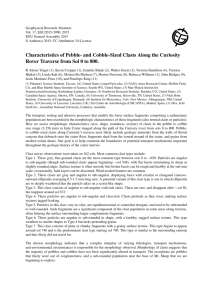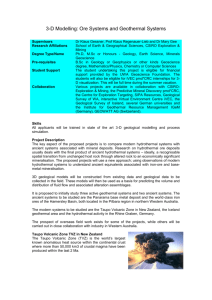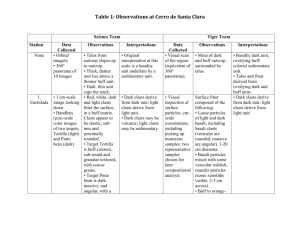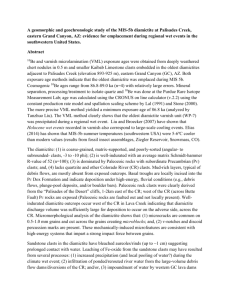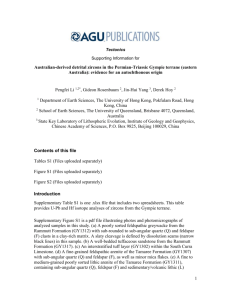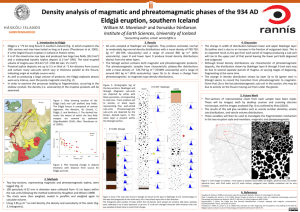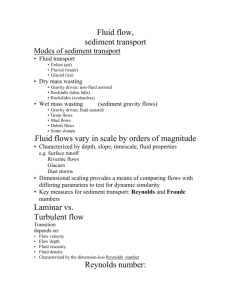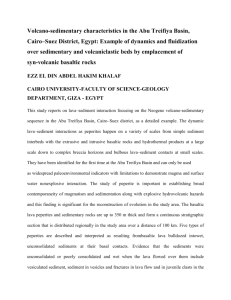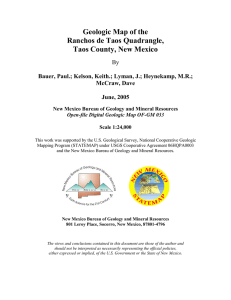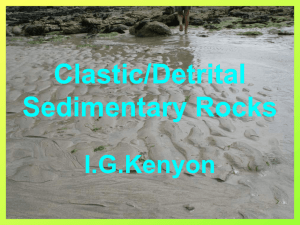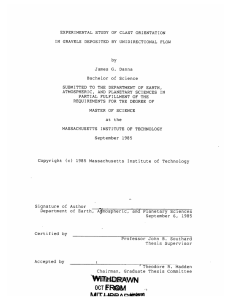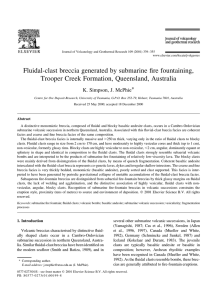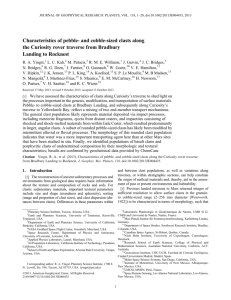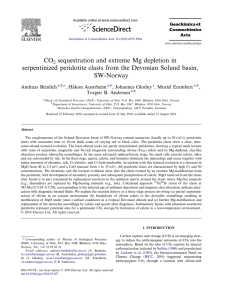doc
advertisement
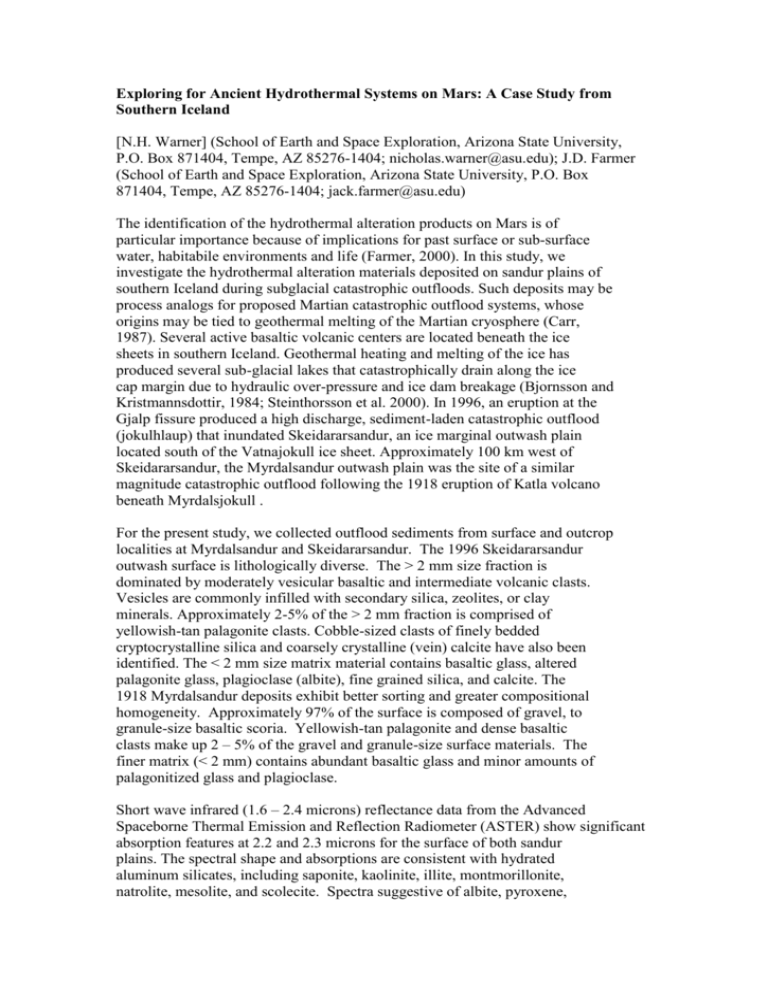
Exploring for Ancient Hydrothermal Systems on Mars: A Case Study from Southern Iceland [N.H. Warner] (School of Earth and Space Exploration, Arizona State University, P.O. Box 871404, Tempe, AZ 85276-1404; nicholas.warner@asu.edu); J.D. Farmer (School of Earth and Space Exploration, Arizona State University, P.O. Box 871404, Tempe, AZ 85276-1404; jack.farmer@asu.edu) The identification of the hydrothermal alteration products on Mars is of particular importance because of implications for past surface or sub-surface water, habitabile environments and life (Farmer, 2000). In this study, we investigate the hydrothermal alteration materials deposited on sandur plains of southern Iceland during subglacial catastrophic outfloods. Such deposits may be process analogs for proposed Martian catastrophic outflood systems, whose origins may be tied to geothermal melting of the Martian cryosphere (Carr, 1987). Several active basaltic volcanic centers are located beneath the ice sheets in southern Iceland. Geothermal heating and melting of the ice has produced several sub-glacial lakes that catastrophically drain along the ice cap margin due to hydraulic over-pressure and ice dam breakage (Bjornsson and Kristmannsdottir, 1984; Steinthorsson et al. 2000). In 1996, an eruption at the Gjalp fissure produced a high discharge, sediment-laden catastrophic outflood (jokulhlaup) that inundated Skeidararsandur, an ice marginal outwash plain located south of the Vatnajokull ice sheet. Approximately 100 km west of Skeidararsandur, the Myrdalsandur outwash plain was the site of a similar magnitude catastrophic outflood following the 1918 eruption of Katla volcano beneath Myrdalsjokull . For the present study, we collected outflood sediments from surface and outcrop localities at Myrdalsandur and Skeidararsandur. The 1996 Skeidararsandur outwash surface is lithologically diverse. The > 2 mm size fraction is dominated by moderately vesicular basaltic and intermediate volcanic clasts. Vesicles are commonly infilled with secondary silica, zeolites, or clay minerals. Approximately 2-5% of the > 2 mm fraction is comprised of yellowish-tan palagonite clasts. Cobble-sized clasts of finely bedded cryptocrystalline silica and coarsely crystalline (vein) calcite have also been identified. The < 2 mm size matrix material contains basaltic glass, altered palagonite glass, plagioclase (albite), fine grained silica, and calcite. The 1918 Myrdalsandur deposits exhibit better sorting and greater compositional homogeneity. Approximately 97% of the surface is composed of gravel, to granule-size basaltic scoria. Yellowish-tan palagonite and dense basaltic clasts make up 2 – 5% of the gravel and granule-size surface materials. The finer matrix (< 2 mm) contains abundant basaltic glass and minor amounts of palagonitized glass and plagioclase. Short wave infrared (1.6 – 2.4 microns) reflectance data from the Advanced Spaceborne Thermal Emission and Reflection Radiometer (ASTER) show significant absorption features at 2.2 and 2.3 microns for the surface of both sandur plains. The spectral shape and absorptions are consistent with hydrated aluminum silicates, including saponite, kaolinite, illite, montmorillonite, natrolite, mesolite, and scolecite. Spectra suggestive of albite, pyroxene, and goethite were also identified on the sandur surfaces. Calcite was not identified remotely. Powder x-ray diffraction (XRD) analysis of homogenized surface materials from both sandurs confirmed the presence of zeolite minerals and clays (smectite, illite, and kaolinite) within the palagonite clasts. Albite, pyroxene, and quartz were also identified in the basaltic scoria and palagonite clasts. Oriented powder x-ray diffractograms (< 2 micron fraction) for palagonite clasts revealed randomly ordered smectite (R < 1), mixed layer smectite/illite with 30 – 40% illite concentration, zeolites, quartz, and albite. The hydrated aluminum silicates identified in the remote analysis likely correspond with the clay and zeolite minerals identified in the palagonite clasts by thin section petrography and XRD. The mineral associations present in the palagonite clasts suggest alteration at temperatures near 100 C. Terrestrial analog studies that use remote, field, and laboratory techniques provide a framework for future work at Mars. The sandur plains of southern Iceland are ideal analogs for Martian fluvial systems whose origins may be tied to geothermal activity (Carr, 1987). Remote identification of hydrothermal mineral assemblages within the Martian outflood channels may provide important information regarding the hydrologic, thermal, and (potentially) biologic evolution of the planet. References: Bjornsson, H., H. Kristmannsdottir, 1984, The Grimsvotn geothermal area, Vatnajokull, Iceland, Jokull, v. 34, p. 25 – 50. Carr, M.H., 1987, Water on Mars, Nature (London), v. 326, p. 30 – 35 Farmer, J.D. 2000, Hydrothermal systems: Doorways to early biosphere evolution. GSA Today, v. 10, p. 1-9. Steinthorsson, S., B.S. Hararson, R.M. Ellam, G. Larsen, 2000, Petrochemistry of the Gjalp-1996 eruption, Vatnajokull, SE Iceland, Journal of Volcanology and Geothermal Research, v. 98, p. 79 – 90. POSTER CORRESPONDING AUTHOR: N. H. Warner
